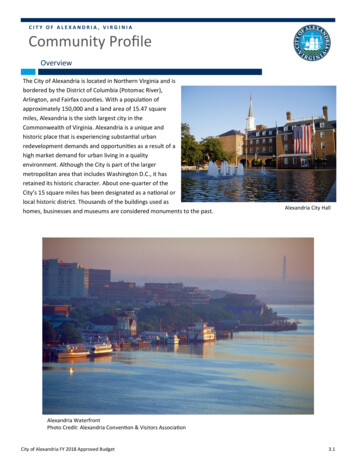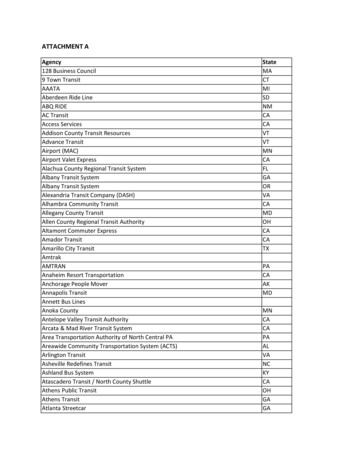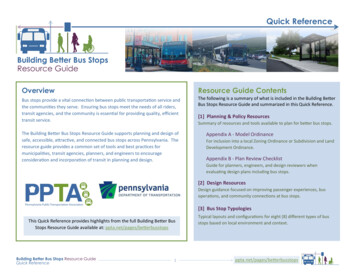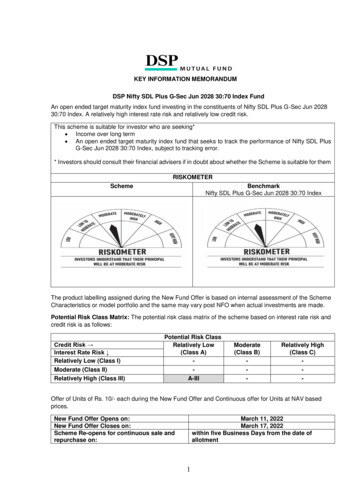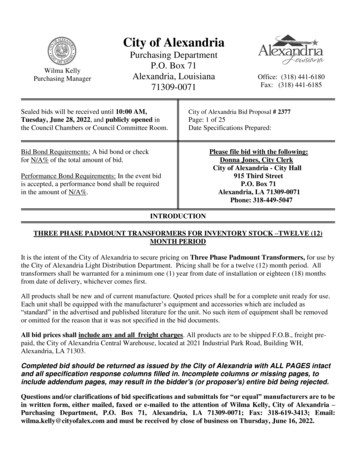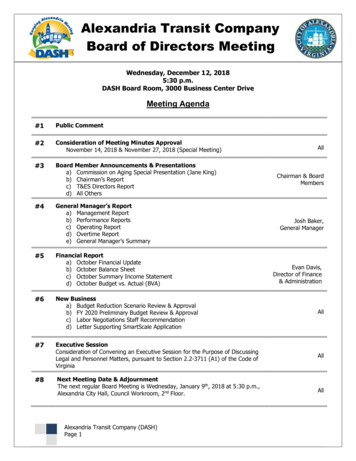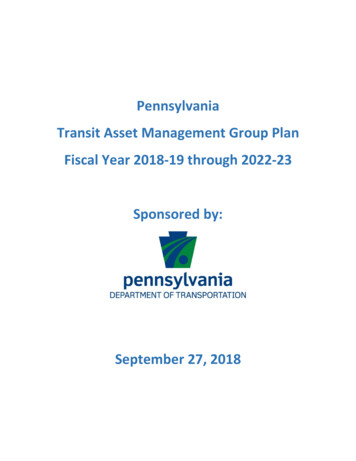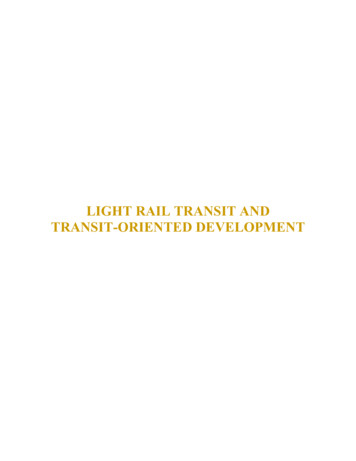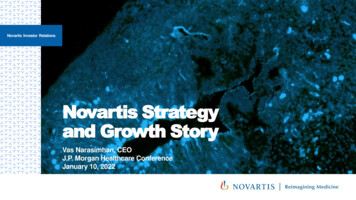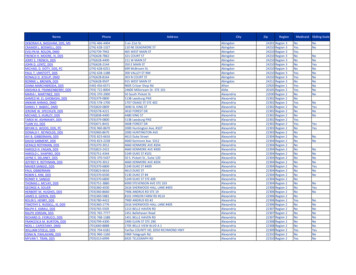
Transcription
FY 2023 – FY 2028ALEXANDRIA TRANSIT COMPANY (DASH)DRAFT TRANSIT DEVELOPMENT PLAN (TDP)PRESENTED TO THE ATC BOARD OF DIRECTORS ON MARCH 9, 2022703.746.DASH (3274)DASHBUS.COM3000 BUSINESS CENTER DR, ALEXANDRIA
TABLE OF CONTENTS1.0 / Executive Summary . 11.1 / System Performance . 11.2 / FY 2023 Service & Fare Change Recommendations . 21.4 / ATC Capital Program Summary . 42.0 / TDP Background . 52.1 / Purpose & Format . 52.2 / Process & Timeline . 52.3 / Alexandria Transit Vision Plan . 63.0 / System Summary . 83.1 / Service Area . 83.2 / Routes . 83.3 / Other Transit Providers . 123.4 / Passenger Facilities . 123.5 / Bus Fleet. 133.6 / Fares . 153.7 / Funding . 154.0 / System Performance. 164.1 / Service Levels . 164.2 / Systemwide Ridership . 174.3 / Ridership by Route . 174.4 / Cost Efficiency . 194.5 / Service Reliability . 204.6 / Access & Mobility. 224.7 / System Performance Summary. 275.0 / Service & Fare Recommendations . 285.1 / Service Recommendations (FY 2023) . 285.2 / Fare Recommendations (FY 2023) . 405.3 / Service Recommendations (FY 2023 – FY 2028) . 405.4 / Future Fare Change Recommendations (FY 2023 – FY 2028) . 426.0 / DASH Capital Budget Program . 466.1 / FY 2023 – FY 2032 Capital Improvement Plan (CIP) . 460 FY2022 – FY2027 ATC Transit Development Plan (FINAL)
6.2 / Fleet Replacement Plan . 466.3 / Fleet Expansion . 486.4 / DASH Electric Bus Program . 506.5 / DASH Facility Expansion . 516.6 / Technology Improvements . 526.7 / Other Capital Outlay Items . 537.0 / Public Outreach . 540 FY2022 – FY2027 ATC Transit Development Plan (FINAL)
1.0 / Executive SummaryThis document represents the FY 2023 – FY 2028 Transit Development Plan (TDP) for the AlexandriaTransit Company (ATC). The Alexandria Transit Company is responsible for the management, operation,and maintenance of the DASH bus system in Alexandria, Virginia.The Transit Development Plan (TDP) provides a comprehensive vision of future service development,fare adjustments, and capital investments based on recommendations from the General Manager, ATCBoard of Directors and DASH staff. More specifically, it evaluates current DASH system performance,outlines projected service levels for FY 2023 based on the draft budget, and provides fiscallyunconstrained guidance on future service changes and capital improvements for the remaining fiveyears of the six-year plan cycle (FY 2024 – FY 2028). The TDP is updated each year by DASH staff and issubject to annual review, amendment, and adoption by the ATC Board of Directors. The document alsoserves as a resource for the City staff as they consider future ATC requests for financial assistance.The FY 2023 Transit Development Plan addresses the period beginning July 1, 2022 and ending June 30,2028. The document has been prepared in accordance with board-adopted procedures and is dividedinto four main sections – System Overview (Section 3), System Performance (Section 4), Service & FareChange Recommendations (Section 5), and Capital Budget (Section 6).The key findings and recommendations of these four sections are summarized below:1.1 / System Performance In FY 2021, DASH was budgeted to operate roughly 311,000 platform hours and 2.9 millionplatform miles of regular DASH service, including I-395 Commuter Choice service. Ultimately,DASH only operated approximately 227,000 platform hours, which was 28 percent lower thanplanned due service reductions related to the COVID pandemic. DASH recorded just over 1.52 million boardings in FY 2021. This represents a 47 percentdecrease from FY 2020, and a 60 percent decrease from pre-pandemic ridership levels in FY2019. DASH On-Time Performance was approximately 88 percent in FY 2021, which represents nochange from FY 2020, but is still above the industry OTP standard of 85 percent. Valid customercomplaints related to schedule adherence also decreased by 50 percent in FY 2021.1 FY2023 – FY2028 ATC Transit Development Plan (DRAFT)
1.2 / FY 2023 Service & Fare Change Recommendations The DASH service plan for FY 2023 can be summarized as follows:oFY 2023 Service Levels (Baseline). Assuming preliminary budget subsidy levels providedby City’s Office of Management and Budget and no service level changes, DASH projectsthat it will operate 311,000 platform hours and roughly 2.9 million annual platformmiles in FY 2023, which is roughly equivalent to the annualized amount of servicebudgeted for FY 2022. These totals include the service enhancements on Line 35 andLine 36A/B that have been funded by the I-395 Commuter Choice Program.oFY 2023 Service Levels (Unfunded ATV Improvements). DASH has also developed analternate, unfunded scenario that includes the service improvements from the 2022Alexandria Transit Vision (ATV) Plan that have not yet been implemented. Theseadditional improvements would increase the annual service totals to roughly 335,000platform hours and 3.1 million platform miles, which represents an increase of roughlyeight (8) percent. These improvements would require 2.6 million in additional annualoperating costs for FY 2023, which has not been included in the preliminary budget.This unfunded scenario would include improvements on Lines 30, 31, 32, 33 and 34 withan emphasis on connectivity between West Alexandria and Old Town and improvingweekend service levels so that all routes run every 30 minutes or better on Saturdaysand Sundays. A full description of the FY 2023 “Unfunded ATV Improvements” scenariois included in Section 5.1.oPotomac Yard Metrorail Station. The new infill Metrorail station at Potomac Yard isscheduled to open by the end of 2022. This station will provide an important railconnection for residents of Del Ray, Arlandria, Fairlington, Shirlington, Potomac Yardand Old Town North. As part of this opening, DASH will be implementing the followingroute changes: Line 33. DASH is proposing to realign Line 33 to serve the new Potomac YardMetrorail station when it opens in late 2022. Line 33 will serve the new busstops on Potomac Avenue adjacent to the new Metrorail station to provide aconvenient Metrorail connection for residents of Del Ray and Arlandria. Line 34. DASH is proposing two major realignments of Line 34 that wouldcoincide with the opening of the Potomac Yard Metrorail Station in late 2022.In Old Town, Line 34 would be relocated from North Fairfax Street to North PittStreet between King Street and 2nd Street to provide better access to bus servicefor communities and new developments along North Pitt Street. Additionally,Line 34 would no longer serve the Braddock Road Metro and would instead berouted north to the new Potomac Yard Metro via the dedicated bus lanes onRichmond Highway and East Glebe Road. Line 36A/B. DASH is proposing to realign Line 36A/B to serve the new PotomacYard Metrorail station when it opens in late 2022. Line 36A/B will serve the newbus stops on Potomac Avenue adjacent to the new Metrorail station to provide2 FY2023 – FY2028 ATC Transit Development Plan (DRAFT)
a frequent, all day bus connection to Metrorail for residents of Del Ray andArlandria, seven days per week.o I-395/95 Commuter Choice Program. In FY 2022, DASH and the City of Alexandria wereawarded funding for two major service enhancements on Lines 35 and 36A/B throughthe I-395 Commuter Choice grant program, which is managed by the Northern VirginiaTransportation Commission (NVTC). The enhanced service on these two routes waslaunched with the New DASH Network in September 2021 and will continue to operatewith grant funding through FY 2023.The following DASH fare-related actions are planned for FY 2023:oFree Fares. DASH will continue as a 100% fare-free operation, as was first introduced inSeptember 2021 with the New DASH Network. The fare-free program will continuethrough FY 2025 as funded by the Transit Ridership Incentive Program (TRIP) from theVirginia Department of Rail and Public Transportation (DRPT) with local support fromthe City of Alexandria.1.3 / FY 2024 – FY 2028 Service & Fare Change Recommendations FY 2024 Service Improvements. In FY 2024, DASH will propose to implement any remainingimprovements from the 2022 Alexandria Transit Vision (ATV) Plan that are not implemented inFY 2023. In addition to these improvements, DASH will propose additional improvements onLine 30, Line 32, Line 103 and Line 104, as outlined in Section 5.3. FY 2025 Service Improvements. In FY 2025, DASH will propose to implement additionalimprovements on Line 32, along with the extension of the King Street Trolley from the KingStreet Metro to Eisenhower Avenue Metro. 2030 Alexandria Transit Vision Plan. DASH will continue to move forward with theimplementation of the 2030 Alexandria Transit Vision Plan in FY 2026 and beyond. Moreinformation on the 2030 Alexandria Transit Vision Plan can be found in Section 5.3 or on the ATVwebsite (www.dashbus.com/transitvision). West End Transitway. DASH will continue to work with the City of Alexandria on the planningfor the West End Transitway, which will replace Line 35 service in the West End. Moreinformation on the West End Transitway can be found in Section 5.3. Duke Street Bus Rapid Transit (BRT). DASH will continue to work with the City of Alexandria onthe planning for the Duke Street Transitway, which is planned between Landmark Mall and theKing Street Metro. More information on the Duke Street BRT can be found in Section 5.3. Fare Changes. No additional fare changes for FY 2024 or beyond are being proposed at thistime.3 FY2023 – FY2028 ATC Transit Development Plan (DRAFT)
1.4 / ATC Capital Program Summary DASH Fleet. As of the start of FY 2023, the current DASH bus fleet will include 101 active buses,and six (6) contingency spare buses. Electric Buses. In FY 2022, DASH purchased and took delivery of eight new 100% electric buses,including four articulated 60-foot New Flyer buses (901-904) and four 40-foot Proterra buses(807-810) to bring the fleetwide total up to 14 electric buses. The eight new buses werepurchased with grant funding from the Northern Virginia Transportation Authority (NVTA). In FY2023, DASH is seeking to purchase up to 18 additional 100% electric buses, including eightreplacement buses, five replacement trolleys, and six expansion buses. The six expansion buseswould be purchased with funding from the Virginia Department of Transportation (VDOT)SmartScale grant program. DASH and the City are also seeking additional funding for electricbuses through several federal grant programs that are sponsored by the Federal TransitAdministration (FTA). Fleet Replacement. The City of Alexandria’s FY 2023 – FY 2032 Capital Improvement Plan (CIP)includes substantial funding for DASH replacement buses that will allow DASH to maintain itsState of Good Repair (SGR) and continue its transition to electric buses. Based on City budgetguidance, the proposed CIP includes funding for eight clean diesel replacement buses in FY2023, which may be upgraded to 100% electric buses if DASH and the City are able to secureadditional FTA funding through the FY 2023 Low/No Emission Vehicle grant program. The totalrequested funding in the FY 2023 – FY 2032 CIP for replacement bus purchases – including thetransition to a zero-emission fleet – is 105 million. Zero-Emission Fleet Planning. DASH is continuing to work with a consultant team from WSP,Inc. on its Zero-Emission Bus Implementation Plan. Phase II of the plan is expected to becompleted later this year and will guide DASH in its effort to transition the entire bus fleet to100% electric propulsion by 2037. DASH Facility Expansion Project. In early 2022, DASH launched the design phase for its majorfacility expansion project, funded by the state’s Smart Scale program. The project will allowDASH to expand its facility onto the existing city impound lot that is located immediately west ofthe existing DASH garage. The expansion will include capacity for up to 45 additional buses andelectric charging equipment and infrastructure in support of a future zero-emission bus fleet. Italso includes six expansion buses to be purchased by FY 2024. Construction of the facilityexpansion project is expected to be completed by 2024. Other Capital Improvement Projects. Additional FY 2023 – FY 2032 CIP funds are allocatedfuture fleet expansions, hybrid battery and powertrain replacements, on-route electric buscharging stations, and other DASH technology needs.Finally, DASH has also submitted two applications for the FY 2023 Virginia Department of Rail and PublicTransportation (DRPT) grant cycle. These applications would provide funding for DASH promotionalactivities through the Transit Recovery Marketing grant program, and the continuation of the DASHPublic Transit Intern program for FY 2023.4 FY2023 – FY2028 ATC Transit Development Plan (DRAFT)
2.0 / TDP BackgroundThe Transit Development Plan is prepared each year to document and present the General Manager’srecommendations relating to service, fares and the capital budget for the upcoming fiscal year. The planalso serves as a planning and budgetary road map for the following five years. To this end, the TDPprovides an evaluation of the existing DASH bus service and a corresponding outline for future servicedevelopment and capital investment. The plan aligns with the budgetary assumptions for the upcomingfiscal year (FY 2023) and will be used as a starting point for budget discussions in future fiscal years (FY2024 – FY 2028).2.1 / Purpose & FormatThe Transit Development Plan (TDP) is designed to provide a comprehensive vision of future servicedevelopment, fare adjustments, and capital investments based on recommendations from the GeneralManager, ATC Board of Directors and DASH staff. More specifically, it evaluates current DASH systemperformance, outlines projected service levels based on the FY 2023 draft budget, and provides fiscallyunconstrained guidance on future service changes and capital improvements for the remaining fiveyears of the six-year plan cycle (FY 2024 – FY 2028). The TDP is updated each year by DASH staff and issubject to annual review, amendment, and adoption by the ATC Board of Directors. The document alsoserves as a resource for the city staff as they consider future ATC requests for financial assistance2.2 / Process & TimelineThe TDP approval process is designed to run in parallel with the City of Alexandria’s annual budgettimeline. As shown in Table 2-1, the basic TDP assumptions are developed by DASH management in thelate fall and early winter. A draft of the TDP is typically submitted to the Board of Directors and releasedfor public review in March. This release marks the beginning of the public comment period thatculminates with a formal public hearing at the April meeting of the ATC Board. The public commentperiod includes multiple virtual community meetings, online engagement and the opportunity forcomments to be submitted via phone, email, or during the Public Hearing at the Board of Directorsmeeting in April.DASH staff reviews all input and modifies the document as needed to incorporate feedback and alignwith the final city budget. The final ATC Transit Development Plan is then reviewed and adopted by theATC Board of Directors in May so that the plan may be implemented for the subsequent fiscal year onJuly 1st.5 FY2023 – FY2028 ATC Transit Development Plan (DRAFT)
Table 2 – 1 / Annual ATC Transit Development Plan (TDP) TimelineATC StaffATC BoardStaff submits current budget to Draft FY23 budget presented toOMBATC Board for inputStaff submit suppl. requests and BOARD ACTION to approve orNovemberreductions to OMBamend proposed uneN/AN/ACity Staff/OMB/CouncilCity Manager releases prioritiesand instructionsSuppl. requests and reductionsdue to OMB.Focus Area Teams meetStaff meet with OMB and CityN/ACity Manager finalizes budgetManagerStaff receives subsidy level fromManager releases proposedN/AOMB, revises budgetbudget/CIP to City CouncilProposed TDP & BudgetProposed TDP & BudgetCity Council Budget Workcompleted; outreach beginspresented to Board for inputSessionsStaff present budget to Council, Board holds Public Hearing forCity Council Budget Workconduct public outreachProposed FY23 TDP & BudgetSessionsStaff develops final TDP/Budget BOARD ACTION to adopt revised City Council adopts FY23 Budgetbased on inputFY23 TDP and Budgetand Capital Imp. Program (CIP)Prepare for implementation ofN/AN/Aany July service/fare changes2.3 / Alexandria Transit Vision PlanThe Alexandria Transit Vision (ATV) Plan is anambitious bus network redesign study conductedby DASH and the City of Alexandria to take acommunity-driven approach to re-designing thecity’s transit network from scratch. The ultimategoal of the ATV – as determined throughcommunity outreach – is to create a more useful bus network that encourages more people to go moreplaces at more times using transit. Similar transit network redesigns have been successfullyimplemented in Houston, Seattle, San Jose, and Richmond.After three rounds of public engagement and nearly two years of discussion, the final 2022 and 2030Alexandria Transit Vision Plan networks were adopted by the DASH Board of Directors in December2019. The networks were designed based on the policy guidance that DASH should dedicate 85 percentof its annual revenue hours to ridership maximization, and 15 percent to coverage-oriented service. Theresulting 2022 and 2030 ATV recommendations create a network of frequent, all-day bus routes acrossthe City of Alexandria that provides significant improvements in mobility options for most Alexandriaresidents and encourage additional transit usage, which benefits the City as a whole. Majorimprovements to off-peak service during middays, evenings and weekends would also be included.The first implementation phase of the Alexandria Transit Vision Plan – known as the “New DASHNetwork” – was launched in September 2021. Due to budget constraints and other major DASH funding6 FY2023 – FY2028 ATC Transit Development Plan (DRAFT)
needs, the City was not able to fund the full 2022 ATV Plan recommendations in FY 2022, and they arenot currently proposed for FY 2023.DASH was able to implement a reduced version of its 2022 ATV Plan in September 2021 with the farefree New DASH Network, and will seek additional funding opportunities in FY 2023 and beyond in thehopes of implementing the full 2022 Alexandria Transit Vision Plan. Additional service change proposalsfor FY 2024 and beyond would allow DASH to implement the full 2022 and 2030 ATV network plans andare included in Section 5-3.7 FY2023 – FY2028 ATC Transit Development Plan (DRAFT)
3.0 / System SummaryDASH currently operates traditional fixed-route bus service on eleven regular bus routes, and the KingStreet Trolley. The primary DASH service area covers approximately 15 square miles and generally alignswith the jurisdictional boundaries of the City of Alexandria. A map of the DASH bus system is included asFigure 3-1. An inset map depicting bus service in Old Town Alexandria is shown as Figure 3-2.3.1 / Service AreaThe majority of DASH service operates within the City of Alexandria, however, three routes – Lines 35,103 and 104 – also provide service along Interstate 395 between Alexandria and the Pentagon. Asshown in Figures 3-1 and 3-2, the DASH bus system design follows a modified hub-and-spoke networkdesign model with Old Town as the “hub”, and the major east-west arterials (King Street, SeminaryRoad, Duke Street, and Eisenhower Avenue) serving as the “spokes”. Several “crosstown routes” likeLine 36 A/B also provide connections between outlying areas and major trip generators on the West Endand northern Alexandria. DASH provides local bus service within the City, but also connects passengersto the Metrorail system, which has four stations within the City of Alexandria, and a fifth stationscheduled to open at Potomac Yard in late 2022.3.2 / RoutesThe DASH bus system consists of 10 regular bus routes and the King Street Trolley. The basiccharacteristics of each route are summarized in Table 3-1. All eleven routes operate on weekdays andnine routes run on Saturdays and Sundays. On most routes, weekday service runs from at least 6:00 AMto 11:00 PM, and weekend service runs from at least 7:00 AM to 10:00 PM. Weekday peak service formost routes runs every 15-30 minutes. Weekday off-peak service typically runs every 30-60 minutesduring mid-days and evenings. Of the eight routes that run on Saturdays and Sundays, four run every 15minutes or better. On Saturdays, only one of the eight routes runs only every 60 minutes, but onSundays, three of the eight routes only run once every hour. Due to the COVID-19 pandemic, severalDASH routes – the AT-3, AT-4 and AT-6 – operated with reduced service during the first eight months of2021 until the New DASH Network launched in September.DASH also operates the iconic King Street Trolley, a free tourist-oriented service running between theKing Street Metro and City Hall. The trolleys typically run every 15 minutes from 11:00 AM to 11:00 PM,365 days per year. King Street Trolley service was suspended in March 2020 due to the pandemic, butresumed regular operations in July 2021.Additional information on the destinations, service levels and operating characteristics for specific DASHroutes is provided in Table 3-1.8 FY2023 – FY2028 ATC Transit Development Plan (DRAFT)
Figure 3 – 1 / DASH System Map9 FY2023 – FY2028 ATC Transit Development Plan (DRAFT)
Figure 3-2 / Old Town Alexandria Inset Map10 FY2023 – FY2028 ATC Transit Development Plan (DRAFT)
Table 3-1 / DASH Service Characteristics by SundaySpanPeakOff-PeakNightSpanFreq.SpanFreq.30Van Dorn Metro to Braddock Road Metro viaLandmark Mall, Van Dorn, King & Old Town5:00am 12:00am10-2030305:45am 12:40am305:45am 11:30pm3031NVCC to Braddock Road Metro via BradleeShopping Center, King Street Metro & Old Town5:00am 12:30am1015-3030-605:45am 12:30am15-305:45am 12:30am15-3032Landmark Mall to King Street Metro via PickettStreet, Van Dorn Metro & Eisenhower Metro5:00am 10:00pm3060607:00am 10:00pm607:00am 10:00pm6033King Street Metro to Potomac Yard viaCommonwealth, Monroe, Mt. Vernon, & Reed6:00am 10:00pm3030607:00am 10:00pm307:30am 9:30pm6034Lee Center to Braddock Street Metro via S Royal & 5:00am N Fairfax10:00pm3030307:00am 10:30pm307:00am 10:30pm6035Van Dorn Metro to Pentagon Metro via LandmarkMall, Mark Center, and I-3954:45am 12:30am101015-305:45am 3:00am155:45am 2am15Mark Center Station to Potamac Yard via Southern 6:00am Towers, Bradlee Shopping Center, & Glebe11:00pm1515157:00am 10:45pm157:00am 10:45pm1536A/B102Mark Center Station to King Street Metro viaSeminary & King5:00am8:00pm3060-----103Braddock Road Metro to Pentagon Metro viaRussel, Glebe, & Parkfairfax6:00am 8:00pm30------104Braddock Road Metro to Pentagon Metro viaCameron Mills Drive and Parkfairfax6:15am 8:15pm30------KSTKing Street 11:00pm1511 FY2023 – FY2028 ATC Transit Development Plan (DRAFT)
3.3 / Other Transit ProvidersThe DASH bus network in Alexandria provides a local complement to the regional transit network.Regional operators that provide service to/from Alexandria include: Metrorail (WMATA). Metrorail operates heavy rail service to 91 stations throughout theWashington, DC region, and typically carries over 180 million passengers per year. The City ofAlexandria is served by the Blue and Yellow lines at four different Metrorail Stations – BraddockRoad, King Street, Eisenhower Avenue, and Van Dorn. These four stations typically draw about40 million passenger boardings per year. DASH also provides service to the Pentagon MetroStation in Arlington County. The new Potomac Yard Metrorail Station – an in-fill station innorthern Alexandria on Potomac Avenue – is slated to open in late 2022. Metrobus (WMATA). In addition to Metrorail, WMATA also operates a regional bus networkthat typically carries over 130 million passengers per year. Metrobus runs 24 routes thatprovide service within the City of Alexandria. This includes the “Metroway” rapid bus servicebetween Pentagon City and Braddock Road Metro, and the Richmond Highway Express (REX),which provides frequent, limited-stop service from Mount Vernon to Old Town via Route 1.Annual Metrobus ridership in Alexandria is typically around 17 million boardings per year.Several Metrobus routes, including the 7A, 25B and 28A, as part of the New DASH Networklaunch in September 2021. Amtrak/Virginia Railway Express. Intercity and commuter rail services such as Amtrak and VREstop at Alexandria Union Station, before crossing the Potomac River into Washington, DC. VREtypically carries up to 5 million passengers per year. Private Shuttles. Several dozen private shuttles operate within the City of Alexandria to provideconnections to Metrorail Stations. Examples include the Carlyle/PTO Shuttle, and the Van DornExchange shuttle, which connects the Van Dorn Exchange apartment complex with the Van DornMetro. Accessible Service. Accessible paratransit options are provided through the City of Alexandria’sDOT program and the WMATA MetroAccess service.s3.4 / Passenger FacilitiesDASH buses provide service to five Metrorail Stations (Braddock Road, King Street, Eisenhower Avenue,Van Dorn Avenue and Pentagon), five non-Metrorail transit centers (Landmark Mall, Mark Center,Southern Towers, NVCC-Alexandria and Potomac Yard), and over 500 local bus stops. Roughly 22percent of these stops are shared by Metrobus or another provider. City staff estimate that roughly 70DASH bus stops have shelters, while another 200 have amenities such as benches and/or trash
additional FTA funding through the FY 2023 Low/No Emission Vehicle grant program. The total requested funding in the FY 2023 - FY 2032 CIP for replacement bus purchases - including the transition to a zero-emission fleet - is 105 million. Zero-Emission Fleet Planning. DASH is continuing to work with a consultant team from WSP,
